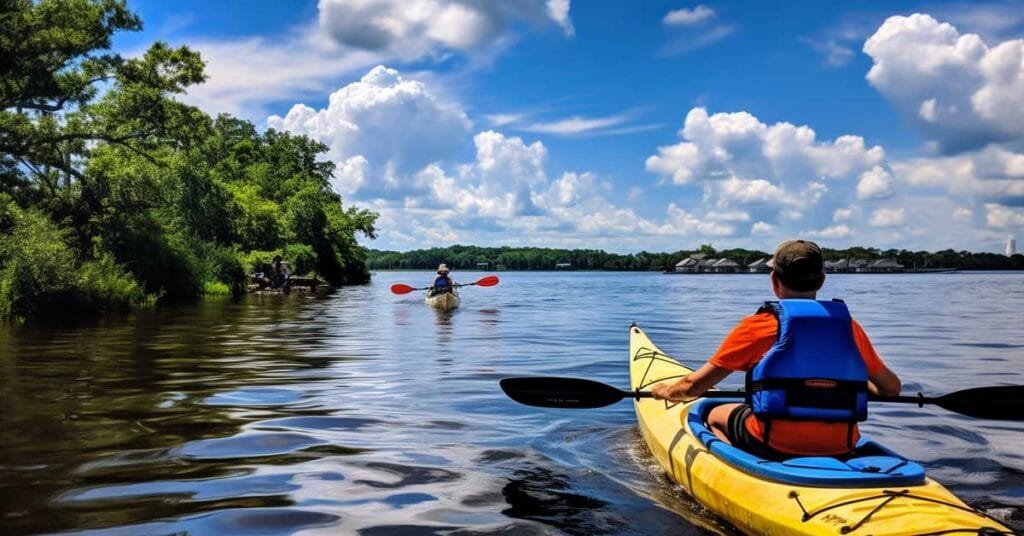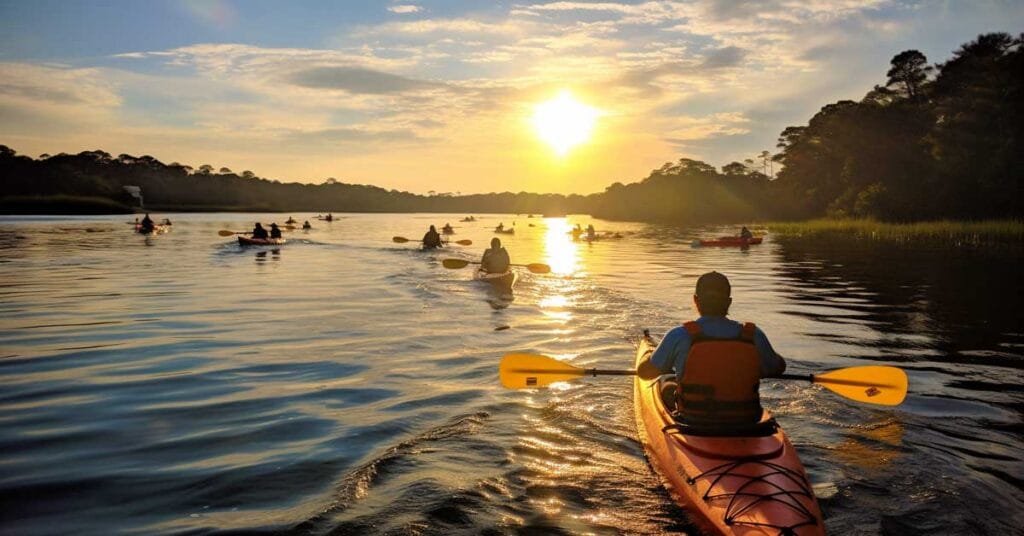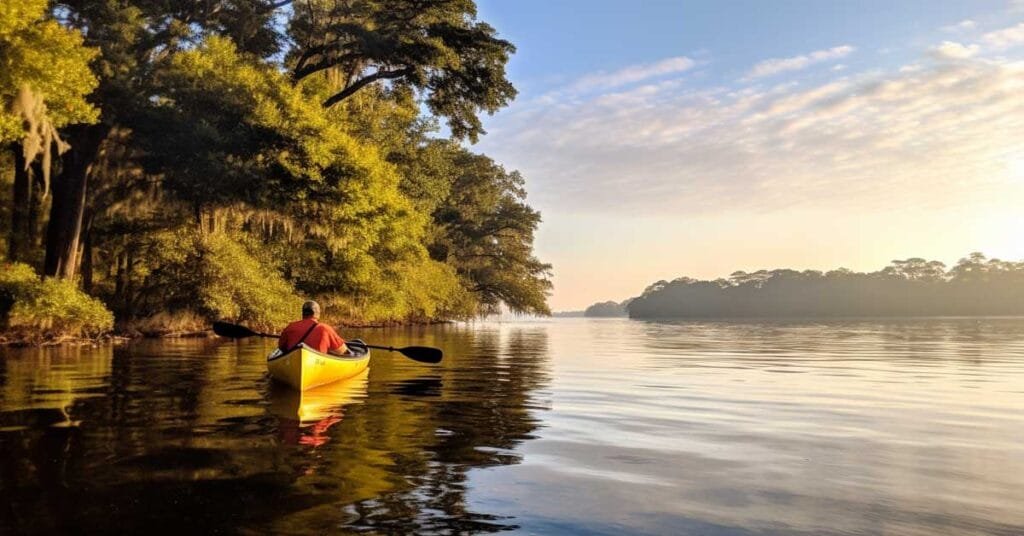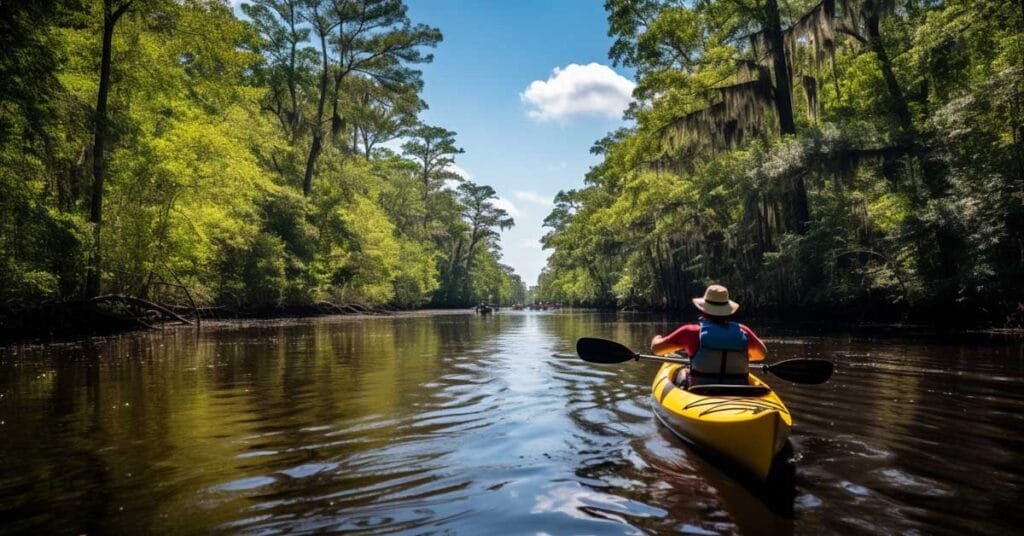North Carolina’s Cape Fear River Region has a magnificent blend of history, culture, and diverse natural beauty. It’s truly a paddler’s paradise. As one of the largest and most significant water systems on the East Coast, it offers a wide range of unique experiences for kayaking enthusiasts. This kayaking guide is designed to equip you with all the necessary information you need to embark on a memorable kayaking adventure in the Cape Fear River Region.
You’ll learn about the natural beauty and ecological importance of the region, various kayaking routes to explore, wildlife you may encounter, safety tips for a successful trip, and local facilities and services to support your adventure. We’ve consulted with local experts, seasoned paddlers, and trusted sources to ensure you’re equipped with accurate and helpful information.
Table of Contents
- The Beauty and Importance of the Cape Fear River Region
- Top Kayaking Routes to Explore
- Wildlife Encounters: Flora and Fauna
- Safety Tips for Kayaking
- Local Facilities and Services
- Frequently Asked Questions
- Warpping Up
- Sources
The Beauty and Importance of the Cape Fear River Region
The Cape Fear River Region is a distinctive natural treasure in the southeastern United States. Spanning over 200 miles from the Piedmont region to the Atlantic Ocean, the river system is a complex matrix of tributaries, wetlands, and estuaries. Each unique micro-habitat contributes to an intricate ecological tapestry that supports a myriad of flora and fauna. It’s this ecological richness and diversity that make the Cape Fear River an essential conservation focus.
The Cape Fear River is undeniably beautiful, offering scenic vistas that captivate the hearts of nature lovers. Its landscapes are remarkably diverse; the tranquil headwaters in the north transition into sweeping wetlands and majestic forests before finally culminating in a vast estuarine ecosystem as the river meets the sea. This natural beauty provides countless opportunities for recreation and nature appreciation. Kayaking, in particular, offers a unique perspective, allowing you to immerse yourself in the river’s diverse landscapes.
But the river’s significance extends beyond its natural beauty. It’s a lifeblood for the region, providing drinking water for over a million people and supporting vital economic activities, including agriculture, fishing, and tourism. Historically, the river served as a key navigation route for Native American tribes and early European settlers. Today, it continues to play an important role in transportation and commerce.
Ecologically, the Cape Fear River serves as a critical habitat for a wealth of wildlife species. The region boasts a high level of biodiversity, with species ranging from alligators and turtles to fish like the Atlantic sturgeon and striped bass. Bird watchers flock to the area to glimpse species such as ospreys, egrets, and the endangered red-cockaded woodpecker. Many of these species depend on the river for their survival, reinforcing the river’s ecological importance.
The river’s wetlands play a crucial role in flood control and water purification, filtering out pollutants and buffering the impact of storms and hurricanes. They also act as a significant carbon sink, helping to mitigate the effects of climate change. The bald cypress swamps, for instance, are among the world’s most effective carbon storages per unit area, underscoring the global environmental importance of this regional ecosystem.
Despite its natural beauty and ecological significance, the Cape Fear River Region faces several environmental challenges. Pollution, habitat destruction, and climate change threaten the river’s health and the wildlife it supports. Therefore, it’s critical that we all work to protect and preserve this vital waterway for future generations.
Engaging in responsible recreational activities, like kayaking, is one way to cultivate an appreciation for the river and its unique ecosystems. By experiencing the river’s splendor firsthand, we can better understand the need for its preservation.
Top Kayaking Routes to Explore
The Cape Fear River presents an extensive network of waterways, with numerous paddling routes that offer unique perspectives of the region’s diverse ecology. From serene freshwater passages to expansive coastal vistas, there are kayaking adventures to suit every taste and skill level. Here are some of the top routes you might consider:
- Headwaters in the Piedmont: Begin your journey where the Cape Fear River is born. The headwaters are a tranquil setting ideal for beginners. Kayaking these waters offers paddlers a chance to glide past rolling hills, fertile farmlands, and through small-town river communities.
- Haw River Paddle Trail: A tributary of the Cape Fear River, the Haw River offers 14 individual paddle trails ranging from 1.5 to 11 miles. This is an excellent choice for those looking to explore the river’s lush riparian landscapes and rich biodiversity.
- Raven Rock State Park: This stunning route takes you along a beautiful and secluded portion of the Cape Fear River. The park’s towering cliffs, covered in mountain laurel and rhododendron, are a sight to behold.
- Wilmington Urban Route: Starting at River Road Park, this route takes you through Wilmington’s historic downtown. As you paddle along, you’ll enjoy views of Battleship North Carolina, the city’s skyline, and potentially spot some wildlife. It’s a great way to enjoy the blend of nature and city life.
- Cape Fear Estuary: As the river meets the Atlantic Ocean, the estuarine waters provide a different kind of kayaking experience. Marshes and sandbars dot this broad, open landscape, and the brackish water teems with marine life. Keep in mind, this area can be challenging to navigate due to tides and wind.
- Black River Paddle Trail: The Black River is a preserved tributary of the Cape Fear River and offers some of the oldest trees in the Eastern United States. Paddlers can traverse through ancient bald cypress trees, some estimated to be over 1,600 years old, creating an otherworldly experience.
Before embarking on your journey, remember to check the current water conditions and weather forecasts. Some routes can pose challenges due to rapid currents, tides, or stormy weather. Local outfitters can offer advice and provide detailed maps and gear if required.
Paddling the Cape Fear River is a memorable journey that lets you appreciate the diverse landscapes of North Carolina, from tranquil, secluded forests to lively urban centers. Whether you’re a novice kayaker or an experienced paddler, the Cape Fear River has something for you.
Wildlife Encounters: Flora and Fauna
The Cape Fear River Region is a biological hotspot teeming with diverse species. Its variety of ecosystems, ranging from tranquil freshwater streams to brackish estuaries, provides ideal habitats for a broad range of organisms. As a kayaker, you are in a prime position to observe and appreciate the abundance of life that calls this area home.
Birdlife: The river and its surrounding habitats are a paradise for birdwatchers. You might spot the magnificent osprey diving for fish or the graceful great blue heron stalking prey along the shoreline. Other species you may encounter include the belted kingfisher, red-tailed hawk, bald eagle, and various species of egrets, herons, and ducks. The region is also home to the endangered red-cockaded woodpecker and rare species such as the wood stork.
Aquatic life: The river and estuarine waters support a thriving fish population, including species like the largemouth bass, catfish, and American shad. Atlantic sturgeon, a prehistoric fish species, migrate up the river to spawn. Coastal areas may present sightings of mullet, flounder, and even an occasional dolphin.
Reptiles and Amphibians: The Cape Fear River is known for its population of alligators, particularly in the lower sections of the river. Numerous turtle species, such as the Eastern box turtle and painted turtle, also call the region home. Frogs and salamanders can be found in the river’s wetlands.
Mammals: Be on the lookout for river otters playfully sliding into the water or a white-tailed deer cautiously drinking at the water’s edge. Smaller mammals such as raccoons, beavers, and various species of bats also inhabit the region.
Flora: The riverbanks and wetlands are lined with a variety of plants and trees, creating a lush, verdant backdrop for your kayaking adventure. Towering bald cypress and tupelo trees dominate in the swamps, while pine, oak, and hickory are more common in upland areas. Aquatic plants such as duckweed, water lilies, and cattails add to the diversity.
Remember, while encountering wildlife can be a thrilling aspect of your kayaking experience, it’s essential to maintain a respectful distance and avoid disturbing these creatures in their natural habitats. After all, one of the joys of kayaking in the Cape Fear River Region is the chance to witness nature’s workings up close while leaving no trace of your passage.
Safety Tips for Kayaking
Whether you’re an experienced kayaker or just starting out, safety should be your primary concern on any kayaking trip. Here are some key safety tips to help ensure your journey along the Cape Fear River is both enjoyable and safe:
Check the Weather and River Conditions: Before you set out, check the local weather forecast and current river conditions. Rapid changes in weather can create hazardous conditions. Also, be aware of the water temperature and dress appropriately.
Always Wear a Lifejacket: Known as a personal flotation device (PFD), your lifejacket is your most important piece of safety gear. It should be properly fitted and worn at all times on the water.
Understand the River’s Flow: Currents, particularly in a large river system like the Cape Fear River, can be powerful and unpredictable. Be aware of the river’s flow rate and navigate accordingly. Remember that it can be significantly harder to paddle upstream against a strong current.
Pack the Right Gear: Your gear list should include a whistle for attracting attention, a throw bag with a floating line, a first aid kit, a map of the river, a headlamp or flashlight, sunscreen, plenty of drinking water, and high-energy snacks.
Be Prepared for a Capsize: It’s essential to know what to do if your kayak capsizes. Practice a wet exit and re-entry in a controlled environment so you’ll be prepared if it happens in the river.
Avoid Alcohol: Alcohol and boating do not mix. It can impair your balance, coordination, and judgement, all of which are essential for safe kayaking.
Respect Wildlife: Remember, you are a guest in the home of the wildlife that inhabit the Cape Fear River Region. Keep a respectful distance and never feed wild animals.
Leave No Trace: Protect the natural beauty of the Cape Fear River by carrying out any trash you bring in, and follow the Leave No Trace principles to preserve the area for future generations.
Take a Course or Go With a Guide: Especially for beginners, taking a kayaking course or going with an experienced guide can significantly enhance your safety and enjoyment. They can provide you with essential skills, local knowledge, and additional safety support.
Safety on the water also involves understanding and complying with local regulations. Be sure you know the rules before you head out.
Local Facilities and Services
The Cape Fear River Region is well-equipped to support your kayaking adventure with a range of facilities and services that cater to outdoor enthusiasts. Here’s an overview of what you can expect:
Outfitters: Several local outfitters can provide you with everything you need for your kayaking excursion. Businesses such as Paddle NC and Wilmington and Beaches offer kayak rentals, guided tours, and safety equipment. These experts can also provide advice on the best routes to take according to your experience level and the current river conditions.
Accommodation: If you’re planning a multi-day kayaking trip, or simply need a place to stay before or after your adventure, you’ll find a variety of accommodation options in the region. From campgrounds and RV parks to hotels and vacation rentals, there’s something to suit every preference and budget.
Food and Dining: After a day of paddling, you’ll surely work up an appetite. The region boasts a range of dining options, from cozy cafes and hearty pub food to fine dining establishments. Many towns along the river also have supermarkets or convenience stores where you can stock up on supplies for your trip.
Tourist Attractions: If you’re interested in exploring the region beyond the river, you’ll find plenty of attractions to pique your interest. Visit the historic town of Wilmington, explore the battleship USS North Carolina, or take a leisurely stroll along the scenic Riverwalk.
Emergency Services: In case of emergencies, the region is serviced by several hospitals and medical centers. It’s a good idea to note the nearest facilities to your chosen kayaking route before you set out. Remember, in case of emergency, call 911.
Transportation: If you’re traveling from afar or don’t have your own kayak, you may need to consider transportation options. Some local outfitters offer shuttle services, transporting you and your gear to and from the river. Alternatively, local taxi services or ride-share apps can help you get to and from your drop-in and pick-up points.
Parks and Launch Sites: There are numerous access points along the Cape Fear River for launching your kayak. Many of these are located within state or local parks, which also offer facilities such as restrooms, picnic areas, and hiking trails.
Before your trip, be sure to check the operation hours and any potential fees associated with these services. Your adventure on the Cape Fear River can be much more enjoyable with these facilities at your disposal.
Frequently Asked Questions
Wrapping Up
Kayaking in the Cape Fear River Region is an extraordinary experience, offering the opportunity to delve deep into nature, witness abundant wildlife, and understand the ecological significance of one of the East Coast’s most important waterways. But the most crucial takeaway from this adventure should be a commitment to preserving this natural wonder for future generations to appreciate. Your understanding and respect for the river’s ecology and history are as important as the preparation you take for the trip itself.





